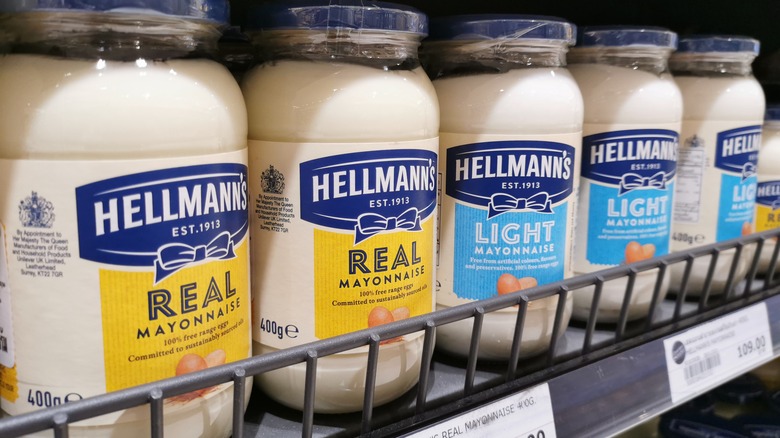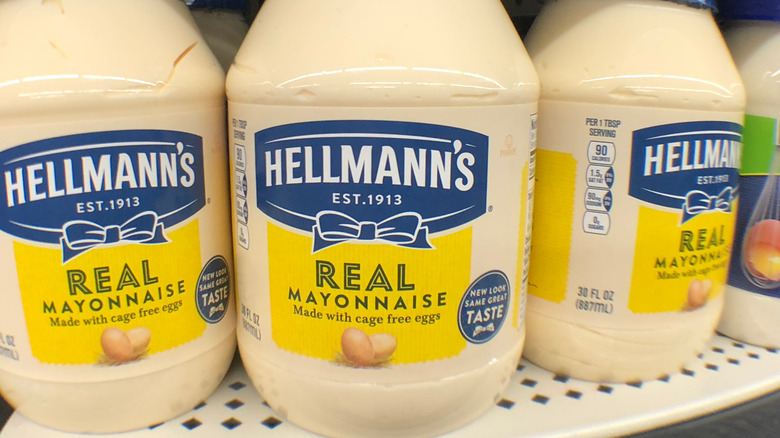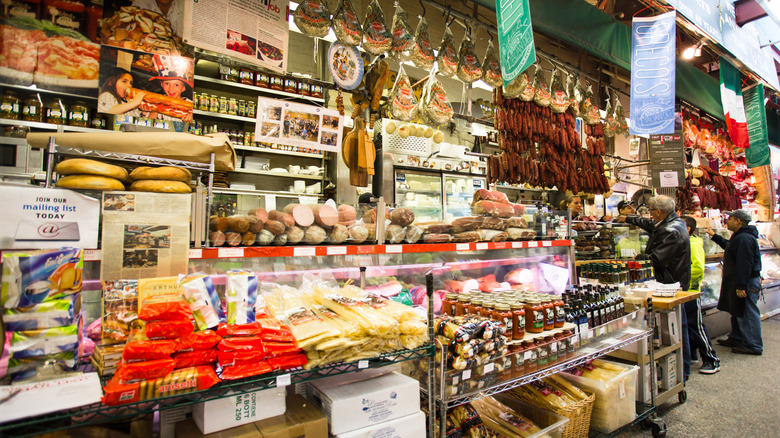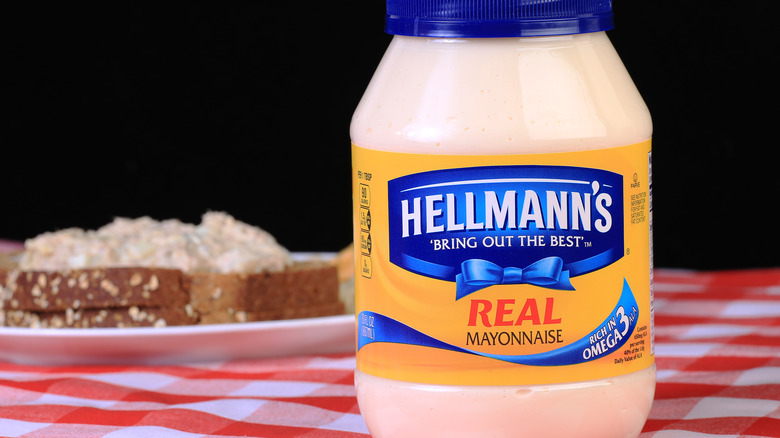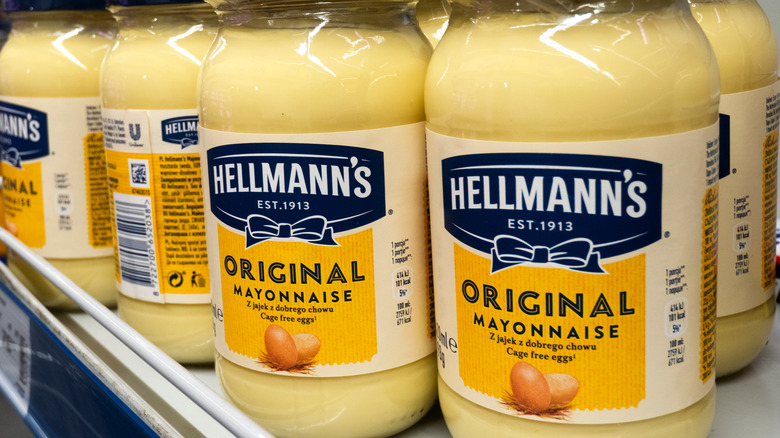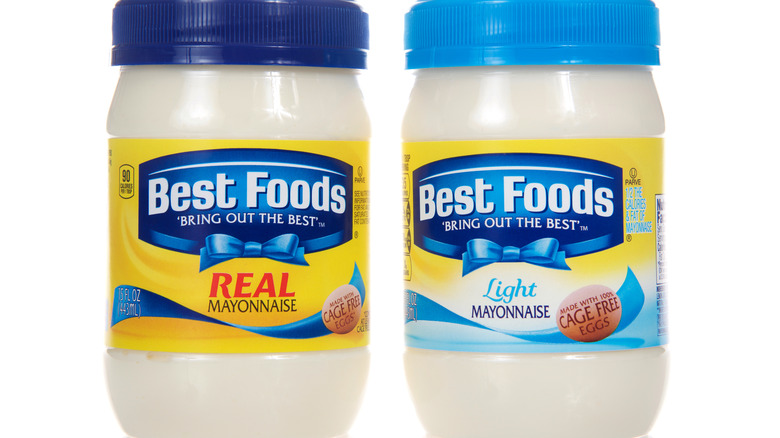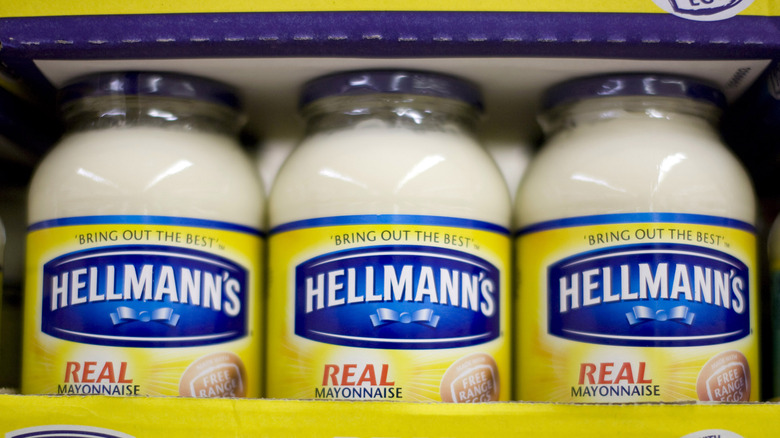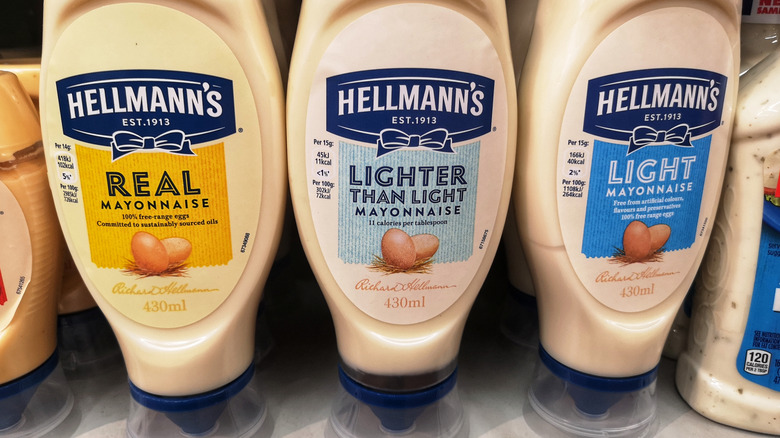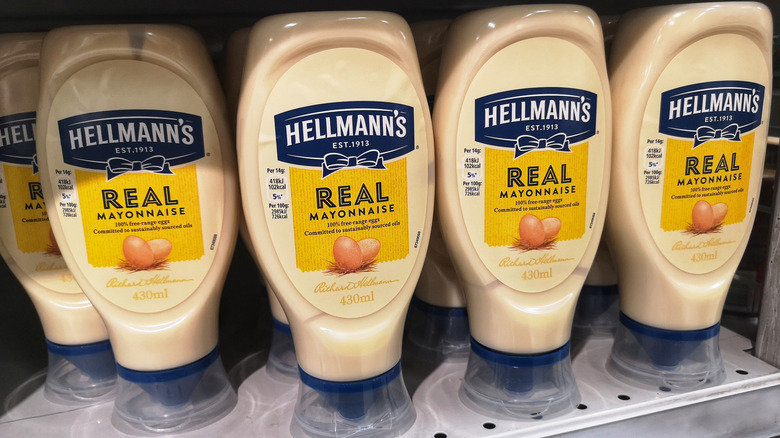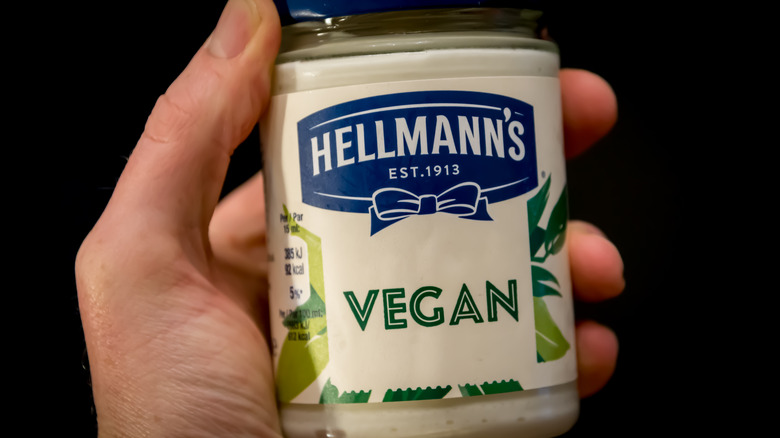12 Facts You Should Master About Hellmann's Mayonnaise
Mayonnaise has just as many haters as it has fans. For some people, mayonnaise is a fluffy, tangy spread used to bind the ingredients in their chicken salad or add a little zest to their sandwiches and burgers. But for others, the condiment is a concoction thought up by the devil himself to ruin their lives. There is even an "I Hate Mayonnaise" Facebook group for these people to gather and share their dislike of the spread.
But whether you love it or hate it, there is one mayo brand that you are likely to recognize, and that's Hellmann's. From its humble beginnings in a New York City delicatessen to a global condiment powerhouse, the mayonnaise brand has certainly had a unique and storied history — including the founder's many brushes with death, to marketing breakthroughs ahead of its time, and controversies over the meaning of "real mayonnaise." And every true Hellmann's fan, no matter how casual, needs to master these facts.
1. A near-death experience led to the creation of Hellmann's mayo
Richard Hellmann, who went on to create the spread we all know today, nearly worked himself to death before his life-changing discovery. According to food historian Andrew Smith, Hellmann was born just outside of Berlin, Germany, in 1876. He moved to the United States in 1903 with a few years of grocery store supply chain management already under his belt. As soon as Hellmann stepped off the boat from Europe, he set about exploring New York City. In a stroke of luck, he found himself outside the offices of Francis H. Leggett Co., a major wholesale grocer in United States at the time.
Hellmann struck up a conversation with the company's vice president, John C. Juhring, who hired Hellmann on the spot. He worked overtime learning everything there was to know about the grocery industry in America. When he left his job at the Leggett Company, Hellmann first rented, then purchased a storefront on the Upper West Side of Manhattan and opened up Hellmann's Delicatessen. He worked around the clock to ensure the success of his business venture. By 1911, the exhaustion and stress of doing too much had made him so sick that his doctor told him he would surely die should he continue, per Smith. So Hellmann sold his business and took his family on a European vacation — where he would make a discovery that changed the course of his legacy.
2. It was originally sold at a deli in New York City
According to food historian Andrew Smith's history of Hellmann's, Richard Hellmann's eventual life-changing legacy was influenced by a trip to Europe in 1912. While there, he visited his friend Matt Martinez in Paris. Martinez also owned a deli and impressed Hellmann with his food distribution system. Hellmann had already been making small batches of mayo at his own shop for customers, but Martinez made wholesale batches and sent them out to other businesses instead.
Not long after, Hellmann was called back to New York. The man he sold his deli to had died and it was once again in need of an owner. In a twist of fate, Hellmann and his family avoided sailing on the Titanic, instead choosing a boat that would get them across the ocean in less luxury, but faster, Smith reports. Thus, Hellmann likely avoided death twice in the pursuit of the perfect mayonnaise.
Back in New York, Hellmann, now with a new lease on life, regained control of his deli. Remembering his time in Paris, he began experimenting with different recipes for mayonnaise to see if he could do it better than Martinez. When he finally perfected his recipe — a blend of egg yolks (rather than the whole egg, which was more common), vegetable oil, vinegar, salt, sugar, and some special seasoning — he began selling it at the deli, which is certainly the ideal place for a sandwich spread to be born.
3. The blue ribbon means it's the best
According to the company's history, when Richard Hellmann first began selling his new mayonnaise recipe at his delicatessen, he continued offering his original version of the spread as well. Customers overwhelmingly loved Hellmann's new mayo. It was sold in small jars, and Hellmann was able to sell the morning's batch by evening and didn't have to worry about storing it at all — a god thing considering refrigeration wasn't a thing yet.
Although Hellmann was confident in his new spread against all others, he needed to consider a better way to package it to sell to other customers and businesses beyond his own shop (per Andrew Smith). So he needed to create something appetizing that would move the product and make it stand out. Hellmann decided to place blue ribbons on his mayonnaise jars, so everyone would know which one was best. He did this because a blue ribbon is commonly given out to mark a first place winner. Soon, customers began asking for the "ribbon" version by name, so Hellmann knew he had a hit on his hands. To keep his success rolling, he permanently added the blue ribbon as the symbol of his product.
4. Early advertising success boosted company sales
Richard Hellmann knew how to sell his product, which is the main reason for the early success of his brand. As soon as his blue ribbon jars began gaining popularity in his store, he began thinking of ways to get the word out on a larger scale, and stay ahead of the competition (per Andrew Smith). He filed for a trademark in 1913, and designed his jars to have a wider mouth than other brands, meaning it was easier to get the mayonnaise out. In the days before squirt bottles, this was a huge advantage. It also meant that customers were likely to go through the jars faster, so they were back to buy more mayonnaise faster, too. It was easy to be reminded of the brand they purchased, as "Hellmann's Mayonnaise" was embossed on the top.
In addition, as Hellmann began making contacts around New York and selling his product to suppliers, he always delivered it in a special truck. The vehicle had "Hellmann's Mayonnaise" printed boldly on the side, so there was no question about what was being delivered. In the early 20th century, this helped Hellmann pick up brand recognition quickly in an emerging market. By 1920, things really began taking off, per Hellmann's.
5. The company has been sold several times
With the success of Hellmann's mayonnaise came a few changes in the business structure throughout the 20th century. And things are no longer all in the family, as the company has been sold several times. The company was first incorporated in February 1916 as Richard Hellmann, Inc. (per Andrew Smith). However, according to Southern Living, it wasn't long before the company was bought out. In 1927 the predecessor of General Foods, the Postum Cereal Company, purchased Hellmann's company.
However, ever the businessman, Hellmann followed his brand across the deal and continued to work for Postum on the board of directors for many years, per The New York Times. Typically, when a creator sells a brand, they cash out and retire, which is what makes Hellmann's continued involvement unique. Even after Hellmann's eventual retirement, the company he built continued to be bought and sold until it fell into the hands of the current owner, Unilever, in the early 2000s.
6. Hellmann's is known as Best Foods in some regions
Would you believe that some Americans have never even heard of Hellmann's mayonnaise? This might sound wild, as the spread is one of the most popular condiment brands in the United States. But if you live west of the Rocky Mountain range, you are likely more familiar with Best Foods, instead. According to The Huffington Post, the company claims that both brands are just different names for the same product.
While Richard Hellmann was building his condiment empire in New York, Best Foods was growing from its home base in California. When General Foods purchased Hellmann's in 1927, it kept acquiring other brands, too. One of these brands was Best Foods, which joined the family in 1932 (via Cook's Info). Per the Huffington Post, representatives from Unilever insist the recipe, branding, and advertising for the two options are identical. However, Best Foods and Hellmann's names were never merged on the shelf due to their unique brand recognition in their respective regions. Tasters of the brands insist that there is a slight difference in the flavors. However, it's possible that it's just personal preference, as the company states they are identical.
7. Some varieties don't need to be refrigerated
There is quite a debate surrounding refrigerating condiments. According to Today, the whole idea behind putting mayonnaise in the fridge versus the pantry is just about making it last longer, but it's actually not necessary. "The bottom line is that mayo doesn't spoil faster than other foods, but the shelf life of even ketchup and mustard is much longer if refrigerated than on the counter,” says health and nutrition editor Madelyn Fernstrom. However, it's worth noting that this tip only applies to commercially prepared foods. If you decide to make some mayo at home, it needs to go straight into the refrigerator. If you don't store it this way, you might get sick from bacteria.
Unilever, which now owns Hellmann's, adds handy storage information to some of its product pages to ensure the best use. For example, a quick look at the mayo squeeze bottle indicates that it's okay to keep it in the pantry. It's a bit different for other varieties, like extra heavy mayo or classic mayo. In these cases, although both products last for up to 180 days, the website won't make a definitive call on the best storage practice. Instead, it points consumers to the individual packages. However, based on the health advice from the USDA, your best bet is to put your jar of Hellmann's in the fridge after you've opened it.
8. You can use Hellmann's in your holiday drinks
We bet you never would have thought to add Hellmann's mayonnaise to anything but your turkey sandwiches and pasta salads. However, did you know that you can use it for a variety of dishes. Mayonnaise pops up in a lot of recipes that you might not expect, including cake! And you can even use some to spice up your holiday drinks. The thick, creamy texture of mayonnaise adds great substance to certain drinks. But before you go adding mayo to your cranberry juice, there is some important context — the trick only really works for cream-based drinks, like eggnog or Baileys Irish Cream (with coffee perhaps!).
In fact, in December 2022, Hellmann's shared its very own eggnog recipe as part of a collaboration between Hellmann's and Muddling Memories, a mixology company based in New York City (via Tasting Table). To get the best results, you can add about ¼-cup of mayo to a creamy blend of whole milk and heavy cream. The mayo is meant to fluff things up and give the drinks a richer, smoother taste. However, as the rest of the ingredients are simple syrup, nutmeg, vanilla extract, cinnamon, rum, apple brandy, and cognac — you won't be able to taste the mayonnaise at all. You'll only be able to feel it.
9. Hellmann's is making moves for the environment
As a brand that deals heavily with plastic bottles and jars, Hellmann's has thrown its hat in the ring to begin making moves for the environment. According to the brand, its parent company, Unilever, is attempting to minimize its contribution to the current global glut of single-use plastics. It is doing this through the "Make Taste Not Waste" initiative. The company intends to ensure all of its packaging is fully recyclable by 2025. Consumers can tell if the packaging is reclaimed, as it will have a slightly darker appearance than what they are used to, per the brand.
To bring awareness to their anti-waste campaign, Hellmann's involved famous comedian Amy Schumer. In 2021, Schumer appeared in a Super Bowl commercial, promoting another arm of the company's environmental project — food waste. In the ad, Schumer acts as the consumer's "Fairy God Mayo" and encourages him to use the product to make a meal out of the leftovers in his fridge instead of throwing them away. In the lead up to the commercial, Schumer shared that Hellmann's donated over 1.2 million pounds of food to those experiencing scarcity (via Parade).
10. Hellmann's mayonnaise continues to rank as some of the best
More than a century after it took the market by storm, Hellmann's still ranks quite well on fan-favorite "best mayo" lists. The market for delicious mayonnaise options is a lot more saturated than it was when Hellmann's first came onto the scene. But even today, the spread has an instantly recognizable flavor that still hits the spot. In fact, the taste is so familiar, it's often referred to as the standard by which other mayos are evaluated (per Slate).
Yet the spread's flavor isn't the only thing that it gains recognition for. In 2015, Hellmann's squeeze bottle won the coveted Association for Dressings & Sauces' "Package of the Year" award. "We worked ... to design a bottle to help consumers get the most out of the product, and the most product out of the bottle," said research and development director Tom Wajda. And today's shoppers know that Hellmann's has traded it's glass jars from the early days for plastic ones with a new, modern design. But the purpose of the packaging remains the same — to sell more Hellmann's.
11. The mayonnaise is real, which is trickier than you might think
You may be surprised to know that real mayonnaise is actually a hard to come by. So when you see "real" on Hellmann's packaging, know that it's a rare accolade to receive. According to McGill University, if a manufacturer wants its mayonnaise to be placed on the list of truly real ones, the condiment has to include a very specific set of ingredients. If it doesn't contain the particular mixture, then the FDA won't qualify it as mayonnaise. And if the seller markets it as such, it could get into trouble for false advertising.
So what is this magic ingredient list? It's shorter than you might think. To be considered real mayonnaise, spreads must include a certain proportion of vegetable oil and egg yolk. Next time you are shopping, take a look at the packaging of the spreads in the condiment aisle. If a certain container just says mayo instead of mayonnaise, then it's likely marketed that way due to its ingredient list. While those who eat the spread use the two terms interchangeably, they are anything but. As one of the first mayonnaises on the market, Hellmann's takes great pride in being real, thus including the distinction on most of its packaging.
12. Hellmann's has a vegan option
While Hellmann's prides itself on making real mayonnaise, not all of its mayos are real. To widen its consumer market, Hellmann's now also sells a vegan mayo option. Since those who keep a vegan diet avoid all animal byproducts including meat, dairy, egg, and honey – there is one notable ingredient missing from the vegan recipe. Instead of mayonnaise, the vegan condiment is marketed as a "Dressing & Spread." The idea is that the consumer will recognize Hellmann's as a mayonnaise brand and use the logo, packaging, and color of the sauce to infer it is a stand-in for mayonnaise.
To give the vegan spread its smooth, creamy taste, Hellmann's has swapped in sunflower oil for eggs (via Smart Label). Although, when the oil is unavailable due to supply chain problems, Hellmann's says it alternates it with the more readily available canola oil. If you have any food allergies to egg, dairy, gluten, or soy, for example, this option is completely free of them, meaning it is safe for you to eat. Hellmann's does not warn about any cross-contamination, so we assume the product is made on a separate line from the egg mayonnaise. To enjoy the vegan option, you can use the spread in the same way you would enjoy classic mayonnaise, as a garnish to veggie burgers or salads, or even as a dip for french fries.
